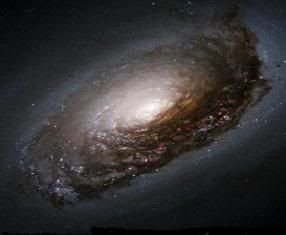|
|
Post by glactus on Nov 23, 2008 8:11:25 GMT
 The Black Eye galaxy Messier 64,The Black Eye Galaxy, (The Sleeping Beauty) was discovered by Edward Pigott in March 1779, and independently by Johann Elert Bode in April of the same year, as well as by Charles Messier in 1780. It has a spectacular dark band of absorbing dust in front of the galaxy's bright nucleus, giving rise to its nicknames of the "Black Eye" galaxy. M64 is well known among amateur astronomers because of its appearance in small telescopes, and is in the Coma Berenices constellation. Distance from Earth is 26 million light years and magnitude 9.3 Recent detailed studies of the galaxy have led to the remarkable discovery that the interstellar gas in the outer regions of M64 rotates in the opposite direction from the gas and stars in the inner regions. The inner region has a radius of only approximately 3,000 light-years, while the outer section extends another 40,000 light-years. This pattern is believed to trigger the creation of many new stars around the boundary separating the two regions. A collision of two galaxies has left a merged star system with an unusual appearance as well as bizarre internal motions. Astronomers believe that the oppositely rotating gas arose when M64 absorbed a satellite galaxy that collided with it, perhaps more than one billion years ago.  Credits: This is a NASA/Hubble image |
|